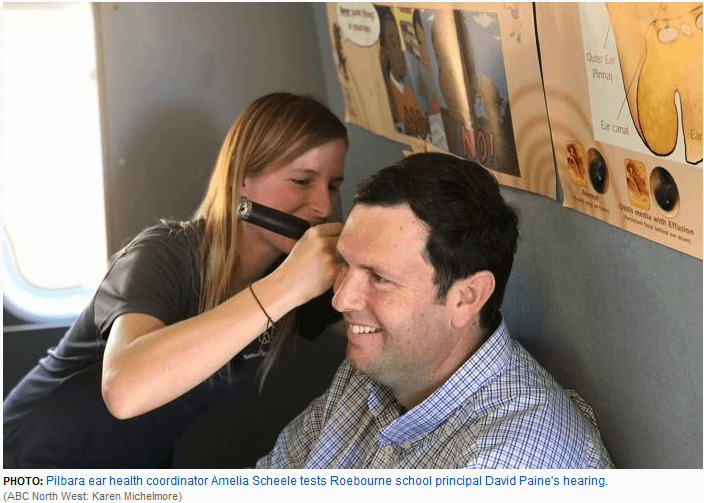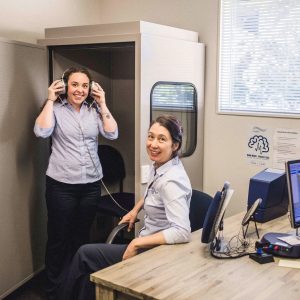Wendy Warrie has had hearing issues all her life
The artist and grandmother who lives in Cheeditha — an indigenous community just outside of Roebourne in the Western Australian Pilbara region — had chronic ear infections that were left largely untreated over decades.
“I’ve been going to the clinic for a long time but they just said there’s lots of holes [in the eardrum] and all of that,” she said.
Ms Warrie attended remote health clinics over the years without any improvement and thought she would be stuck with her poor hearing.
That was until a mobile ear health clinic, inside a minibus, rolled into town.
|
Ms Warrie asked if the clinic — part of the Chevron Ear Health program — could test her hearing, after the service helped her grandchildren improve their hearing.
All three were given baseball caps fitted with hearing amplification devices. “I can hear better now. I could hear a little bit but I had to ask them to repeat what they said,” Ms Warrie said. |
Hearing problems common in the Pilbara
Hearing difficulties are one of the biggest health problems in the Pilbara.
Aboriginal children have the highest rates of otitis media — middle ear infection — in the world, according to the World Health Organisation.Since the Chevron Ear Health program started in 2011, hundreds of children have been tested — and treated.
Telecom Speech and Hearing’s Pilbara ear health coordinator, Amelia Scheel, said hearing problems at a young age could have adverse effects on a child’s speech and language development and their overall learning in the classroom.
“Our attendance rates at clinics have been great — a great increase from when we first commenced with the program to now,” Ms Scheel said.
“It’s steady at probably about an 85 per cent attendance to clinics.
“And almost 100 per cent for our ENT (ear nose and throat specialist clinics), which is absolutely amazing.”
Roebourne school principal, David Paine, said the program had a positive impact on school attendance, behaviour and learning.
“A lot of the issues in learning, a lot of the issues with behaviour is just down to they can’t hear the instruction properly,” he said.
“So if we can alleviate that concern, we can alleviate and address other concerns too.
“We have a lot of students who do not get those regular checks and they have a lot of middle-ear issues, that if not picked up at the early stages easily become into a permanent damage that impacts their entire life.
He said the hearing improvements had changed lives.He highlighted one student who was tested and fitted with a hearing device, inserted into a baseball cap.
“When she first came back in, just seeing her smile, it was really probably her first time when she could really focus in on someone who was speaking and actually hear them,” he said.
“Not just what they’re saying but their tone, their expression, the difference between one person speaking and another, and seeing that light all across their face was truly special and truly amazing.”
Principal also seeks help
Mr Paine was so impressed with the changes in his student’s hearing, it prompted him to face up to the reality of his own hearing issues.
The mobile ear health clinic has started taking adult clients for the first time.
“I didn’t think I had a hearing issue, it was more when I would go to parties or go to clubs I could never hear any conversations, it was just something always that played at the back of my mind,” he said.
“And because every term I was seeing the ear bus staff, I thought maybe I should ask them.
“And this year I built up my courage and said ‘look I’m a bit worried about my ears could you please check my hearing’.”
After discovering he did have a hearing problem, Mr Paine is now on the path to receiving treatment.
(Source: abc.net.au/news)
(Author: Karen Michelmore)





